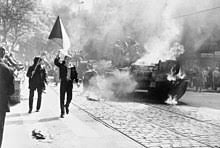“Context of the Cold War and Contemporary Europe” – Everything You Need to Know
The global order that emerged after World War II was deeply influenced by the ideological, political, and economic struggle known as the Cold War. Today, the legacy of that conflict still shapes the landscape of contemporary Europe—affecting everything from international diplomacy and economic policy to cultural identity and social structure. In this comprehensive guide on Context of the Cold War and Contemporary Europe, we will explore how the Cold War laid the groundwork for modern European integration and division, examine key historical events and milestones, and analyze the ongoing influence of these dynamics on today’s political and cultural environment.
Introduction: A Legacy That Continues to Shape Europe
Imagine a continent divided by an invisible yet powerful barrier—a division that once split East from West and continues to influence political alliances, economic policies, and cultural identities even decades after the end of the Cold War. Did you know that although the Iron Curtain fell in 1989, the echoes of Cold War politics still resonate in how European nations interact and define themselves? In this post on Context of the Cold War and Contemporary Europe, we will cover:
- Definition & Key Characteristics: A clear explanation of what the Cold War era entailed and how its legacy manifests in contemporary Europe.
- Historical Background: The origins and critical milestones that set the stage for the Cold War and its impact on post-war Europe.
- In-Depth Exploration: A detailed look at political, economic, social, and cultural developments—from the division of Germany to the rise of the European Union—that illustrate both continuity and change.
- Importance & Applications: Why understanding this context is vital for modern policy-making, international relations, and cultural identity.
- Common Misconceptions & FAQs: Clarifying myths and addressing common questions about the lasting influence of the Cold War.
- Modern Relevance: How recent developments, debates, and research show that the legacy of the Cold War continues to evolve and influence contemporary Europe.
- Call-to-Action: Encouraging further exploration and engagement with this essential part of modern history.
Understanding Context of the Cold War and Contemporary Europe is crucial for grasping how historical events and ideological battles of the past continue to shape our present—and offer valuable lessons for the future.
What Is “Context of the Cold War and Contemporary Europe”?
Defining the Concept
Context of the Cold War and Contemporary Europe refers to the historical framework and evolving legacy of the Cold War period—spanning roughly from 1947 to 1991—and its ongoing influence on modern European society. This concept is characterized by:
Bipolar International Order:
The division of Europe (and indeed the world) into two ideological camps—capitalist democracies led by the United States and communist states led by the Soviet Union.Ideological Conflict:
A struggle between contrasting political and economic systems that not only defined the post-war era but also set the stage for global competition and conflict.Political and Economic Realignments:
The formation of alliances such as NATO and the Warsaw Pact, the division (and later reunification) of Germany, and the emergence of the European Union as a force for integration.Cultural and Social Transformation:
Shifts in national identity, cultural expression, and social policy that reflect both the scars and the progress of the Cold War era.Continuity and Change:
Despite the dissolution of the Soviet Union, many structures, policies, and cultural attitudes shaped during the Cold War persist in contemporary Europe, while new developments continue to redefine the region.
This dual process of continuity and change helps us understand how the Cold War remains an integral part of Europe’s historical context and contemporary reality.
Historical and Contextual Background
The Roots of the Cold War in Post-War Europe
The origins of the Cold War can be traced back to the immediate aftermath of World War II, a period marked by unprecedented destruction, political upheaval, and economic instability. Several key factors set the stage for the division of Europe and the ensuing global rivalry.
1. The Aftermath of World War II
Widespread Destruction:
World War II left Europe devastated, with millions dead and cities in ruins. The need to rebuild fostered both hope and intense competition for resources.Political Vacuum:
The collapse of Nazi Germany and the disintegration of the Axis powers created a power vacuum that the United States and the Soviet Union moved quickly to fill.Economic Devastation:
The war shattered economies across the continent, setting the stage for large-scale reconstruction efforts that would eventually lead to new economic models and alliances.
2. Emergence of the Bipolar World Order
Superpower Rivalry:
With Europe in disarray, the United States and the Soviet Union emerged as the world’s dominant powers. Their conflicting ideologies—capitalism versus communism—laid the groundwork for decades of rivalry.Formation of Alliances:
The establishment of NATO in 1949 by Western nations and the creation of the Warsaw Pact in 1955 by Eastern bloc countries formalized the division of Europe.Key Event – The Iron Curtain:
Winston Churchill’s 1946 “Iron Curtain” speech vividly captured the division between Eastern and Western Europe, highlighting the emerging global order.
3. The Legacy of the Cold War in Contemporary Europe
German Division and Reunification:
The division of Germany into East and West was one of the most prominent symbols of the Cold War. The fall of the Berlin Wall in 1989 and subsequent reunification in 1990 were pivotal moments that reshaped Europe.Economic Integration:
The post-Cold War period saw the rise of the European Union, which aimed to foster economic cooperation and prevent the resurgence of conflict through integration.Cultural and Social Shifts:
The ideological struggles of the Cold War have left enduring marks on national identities and cultural expression, influencing everything from public policy to the arts.
Notable Anecdotes
The Berlin Airlift (1948-1949):
When the Soviet Union blockaded West Berlin, Allied forces organized an enormous airlift to supply the city—a dramatic demonstration of Cold War tensions and international resolve.The Fall of the Berlin Wall (1989):
The peaceful revolution that led to the fall of the Berlin Wall symbolized not only the end of the Cold War but also the beginning of a new era of European integration and democratization.
In-Depth Exploration / Main Body
To fully appreciate Context of the Cold War and Contemporary Europe, we need to explore its multifaceted dimensions—political, economic, social, cultural, and diplomatic. The following sections break down these components with detailed subheadings and real-world examples.
1. Political Dynamics and International Relations
a. The Bipolar World Order
Formation of Blocs:
The Cold War established a clear division between the capitalist West (led by the United States and its NATO allies) and the communist East (led by the Soviet Union and its satellite states). This bipolar structure defined global alliances and set the stage for decades of international rivalry.Diplomatic Tensions:
High-stakes crises such as the Cuban Missile Crisis and the Berlin Crisis underscored the perilous balance of power during the Cold War. These events revealed the world’s vulnerability to nuclear confrontation and shaped modern diplomatic strategies.Example – NATO vs. Warsaw Pact:
The creation of military alliances provided a framework for collective security, while also solidifying the ideological and military divide that persisted until the end of the Cold War.
b. Ideological Influence and Policy Shifts
Capitalism and Democracy vs. Communism:
The ideological battle between Western liberal democracies and Eastern communist regimes influenced domestic policies, economic management, and cultural norms across Europe.Propaganda and Public Opinion:
Both sides used propaganda to shape public perceptions and maintain control. This manipulation of information played a critical role in reinforcing the division and fostering loyalty to the respective blocs.Impact on Governance:
The political structures and institutions established during the Cold War, such as the European Union and the United Nations, reflect the enduring influence of this era in promoting international cooperation and conflict resolution.
c. Reunification and Integration
German Reunification:
The fall of the Berlin Wall in 1989 and the subsequent reunification of Germany marked a turning point in European history. This process not only healed a national wound but also symbolized the broader movement toward European integration.European Union’s Formation:
In the post-Cold War era, the European Union emerged as a key force in fostering economic and political unity. The EU’s development is a testament to the desire for stability and cooperation that arose from the lessons of the Cold War.
2. Economic Transformations and Their Legacy
a. Post-War Reconstruction and Economic Recovery
The Marshall Plan:
One of the most significant economic initiatives of the post-war period, the Marshall Plan provided critical financial aid to rebuild Europe. This program not only jump-started economic recovery but also laid the foundation for a more integrated and cooperative global economy.Economic Modernization:
The reconstruction efforts of the 1950s and 1960s spurred industrial growth, technological innovation, and the expansion of global trade networks—elements that continue to define contemporary Europe.Case Study – Economic Revival in Western Europe:
Countries like West Germany and France experienced rapid economic growth during the post-war period, transforming them into industrial powerhouses and driving the evolution of the modern welfare state.
b. Divergent Economic Paths: East vs. West
Planned Economy vs. Market Economy:
During the Cold War, Western European nations embraced market-oriented economies while Eastern European countries were governed by centrally planned systems. This divergence created lasting economic disparities that have influenced policy debates even after the collapse of the Soviet Union.Integration and Convergence:
The post-Cold War era has seen significant efforts to bridge the economic gap between Eastern and Western Europe through reforms, investments, and integration policies within the European Union.Impact on Global Trade:
The evolution of European economies during and after the Cold War has reshaped global trade dynamics, highlighting the importance of economic cooperation and regulatory frameworks in a rapidly interconnected world.
c. Technological and Industrial Innovation
Advancements Spurred by Conflict:
The technological innovations developed during the Cold War—ranging from aerospace advancements to early computing—have had a lasting impact on global industry and technology.Legacy in Modern Technology:
Many of these breakthroughs paved the way for modern technological progress, influencing everything from consumer electronics to military strategy. The rapid pace of innovation continues to be a hallmark of contemporary European economies.
3. Social and Cultural Dimensions
a. Shaping National Identities and Cultural Narratives
Cultural Memory and the Cold War:
The Cold War profoundly influenced national identities and cultural narratives in Europe. The division between East and West, the struggles for freedom and democracy, and the subsequent reunification have all left enduring marks on how nations define themselves.Art, Literature, and Media:
Creative expressions from the Cold War era—from literature and film to music and visual arts—captured the tensions, hopes, and contradictions of the time. These cultural outputs continue to shape public discourse and influence modern art and media.Example – Cinema and the Cold War:
Films such as Dr. Strangelove and The Lives of Others offer critical reflections on the absurdities and tragedies of the Cold War, providing a cultural lens through which to view historical events.
b. Intellectual and Philosophical Debates
Evolution of Thought:
The ideological battles of the Cold War spurred significant intellectual and philosophical debates. Issues of freedom, surveillance, and state power have been central to academic discourse and continue to influence contemporary political theory.Influence on Education:
The intellectual legacy of the Cold War is embedded in modern educational curricula, which often include studies of political philosophy, international relations, and modern history. This ongoing dialogue ensures that the lessons of the past remain relevant to future generations.Case Study – Postmodernism and the Cold War:
The emergence of postmodernist thought was influenced by the disillusionment and contradictions of the Cold War era. This movement questioned traditional narratives and has continued to shape contemporary cultural and intellectual debates.
c. Social Movements and Human Rights
Civil Rights and Social Reform:
The experiences of division and oppression during the Cold War contributed to the rise of various social movements, including those advocating for civil rights, gender equality, and social justice. These movements have had a lasting impact on European societies.Public Policy and Social Welfare:
The lessons learned from the social challenges of the Cold War era informed the development of modern social welfare systems, which aim to promote equality, protect human rights, and support economic stability.
4. Diplomatic and Geopolitical Implications
a. Shaping Modern International Relations
Institutional Legacy:
The diplomatic structures established during the Cold War—such as NATO, the European Union, and the United Nations—continue to influence global governance. These institutions are crucial for managing contemporary geopolitical challenges.Peace and Security:
The strategies developed during the Cold War for conflict prevention, crisis management, and arms control remain relevant in today’s international relations. They provide a framework for addressing emerging global security threats.Case Study – The European Union:
The EU represents a powerful example of how former divisions can be overcome through economic and political integration. Its evolution is directly linked to the lessons learned from Cold War diplomacy and the need for lasting peace in Europe.
b. Global Power Shifts and Future Challenges
Enduring Rivalries:
Although the Cold War has ended, its legacy continues to shape global power dynamics. The rise of new economic and military powers, along with shifting alliances, reflects the ongoing influence of Cold War-era geopolitics.Anticipating Future Conflicts:
Understanding the historical context of the Cold War is vital for anticipating future international conflicts. By analyzing past diplomatic strategies and geopolitical shifts, policymakers can better navigate today’s complex global landscape.
Importance, Applications, and Benefits
Understanding Context of the Cold War and Contemporary Europe is critical for numerous reasons:
a. Informing Modern Policy and Governance
Strategic Policy-Making:
The diplomatic, economic, and political lessons of the Cold War offer valuable insights for modern governments. Policymakers can draw on historical precedents to design strategies for conflict resolution, economic recovery, and international cooperation.Institutional Strength:
Modern international institutions are built on the foundations laid during the Cold War. Recognizing these roots helps in reforming and strengthening these institutions to better address today’s challenges.
b. Enhancing Civic Engagement and Historical Literacy
Educational Enrichment:
A comprehensive understanding of this period enriches public knowledge and fosters critical thinking about current political and social issues. It empowers citizens to engage more effectively in democratic processes and public debates.Cultural Awareness:
The historical memory of the Cold War shapes contemporary cultural narratives and national identities. This awareness is crucial for fostering social cohesion and promoting mutual understanding in a diverse Europe.
c. Driving Economic and Social Development
Economic Policy Insights:
The economic transformations during the Cold War, including reconstruction and integration efforts, offer important lessons for modern economic policy. Understanding these shifts can help address challenges such as economic inequality and globalization.Social Reforms:
The evolution of social policies in the post-Cold War era has been heavily influenced by the lessons of the past. These reforms continue to drive efforts toward social justice, human rights, and community development.
d. Global Relevance and Future Preparedness
International Cooperation:
The experience of the Cold War underscores the importance of international cooperation in addressing global challenges. This historical context is essential for managing contemporary issues such as climate change, cyber security, and transnational terrorism.Anticipating Future Trends:
The strategic, economic, and cultural shifts of the Cold War provide a framework for anticipating and responding to future global changes. By learning from the past, we can build more resilient and adaptive systems for the future.
Addressing Common Misconceptions and FAQs
Despite its profound impact, several misconceptions about Context of the Cold War and Contemporary Europe persist. Let’s address some frequently asked questions:
FAQ 1: Was the Cold War purely a military standoff?
- Misconception:
Some believe the Cold War was only about military confrontation and arms races. - Reality:
While military rivalry was a significant aspect, the Cold War was also an ideological, economic, and cultural conflict that affected every facet of society.
FAQ 2: Has the Cold War’s legacy disappeared with the fall of the Soviet Union?
- Misconception:
Critics sometimes claim that since the Soviet Union collapsed in 1991, the Cold War is irrelevant today. - Reality:
The influence of Cold War policies, institutions, and cultural narratives persists in contemporary international relations, economic systems, and social identities. Its legacy remains a key factor in shaping global dynamics.
FAQ 3: Do all European nations share the same Cold War experience?
- Misconception:
It is sometimes assumed that the Cold War affected all European countries uniformly. - Reality:
The impact of the Cold War varied significantly between Western and Eastern Europe. While Western nations experienced the benefits of democratic governance and economic integration, many Eastern European countries faced years of authoritarian rule and economic challenges, which continue to influence their development today.
FAQ 4: Can the lessons from the Cold War help prevent future conflicts?
- Misconception:
Some doubt the practical relevance of historical analysis for modern conflict prevention. - Reality:
The lessons of the Cold War—such as the importance of diplomacy, international cooperation, and robust institutions—are essential for addressing today’s global challenges and preventing future conflicts.
Modern Relevance and Current Trends
a. Shaping Contemporary International Relations
Evolving Diplomatic Practices:
The diplomatic strategies and international institutions that emerged during the Cold War continue to shape global politics. Modern alliances, conflict resolution mechanisms, and international law are deeply influenced by this historical period.Ongoing Security Challenges:
Issues such as cyber warfare, nuclear proliferation, and regional conflicts are managed using frameworks that were developed in response to Cold War tensions. Understanding these origins is crucial for modern security policy.
b. Economic Policy and Global Integration
Economic Recovery Models:
The post-war economic strategies—like the Marshall Plan—offer blueprints for economic recovery and integration that are relevant to today’s globalized economy. These models help governments design policies to stabilize markets and promote sustainable growth.Trade and Globalization:
The legacy of economic policies from the Cold War era continues to influence global trade dynamics and financial regulation, making historical insights essential for contemporary economic governance.
c. Cultural and Social Dimensions
Cultural Identity and Memory:
The collective memory of the Cold War continues to shape European cultural identity. Museums, memorials, and educational programs help preserve this legacy and promote dialogue about freedom, unity, and reconciliation.Art and Intellectual Movements:
The artistic and intellectual expressions of the Cold War era continue to inspire contemporary creative practices and scholarly debates. These cultural outputs offer valuable perspectives on the human experience during times of ideological conflict.
d. Preparing for Future Global Challenges
Interdisciplinary Approaches:
Modern scholars and policymakers are increasingly using interdisciplinary methods—drawing from history, economics, political science, and cultural studies—to address the complexities of today’s global challenges.Resilience in Global Governance:
The lessons of the Cold War underscore the importance of building resilient, adaptable institutions that can navigate economic, political, and security challenges in an interconnected world.
Conclusion: The Enduring Legacy of the Cold War in Contemporary Europe
Summarizing the Key Points
Context of the Cold War and Contemporary Europe reveals the complex interplay of historical forces that continue to shape the modern world. Key takeaways include:
Complex Interactions:
The Cold War was not only a military and ideological conflict; it also brought about significant economic, social, and cultural transformations that have left an enduring legacy.Reshaping Europe:
The division and subsequent reunification of Europe, the establishment of international institutions, and the evolution of economic policies are all outcomes of this transformative period.Modern Relevance:
The diplomatic, economic, and cultural lessons from the Cold War continue to influence contemporary European policies and global interactions.Empowerment Through Knowledge:
Understanding the context of the Cold War provides invaluable insights into current international challenges, enabling us to build a more resilient, cooperative, and inclusive future.
Reinforcing the Importance of This Historical Context
Grasping the Context of the Cold War and Contemporary Europe is crucial for anyone interested in understanding how historical events shape modern realities. The interplay between enduring structures and transformative changes offers essential lessons for policy-making, cultural development, and international relations.
A Call-to-Action
We invite you to:
- Explore Further:
Read seminal works such as The Cold War: A New History by John Lewis Gaddis and Iron Curtain: The Crushing of Eastern Europe, 1944-1956 by Anne Applebaum. Engage with documentaries, online courses, and museum exhibits to deepen your understanding. - Engage in Discussion:
Share your insights, questions, and reflections in the comments below or on our social media channels. How do you see the legacy of the Cold War influencing contemporary European politics and global affairs? - Stay Informed:
Subscribe to our newsletter for more in-depth articles on historical transformations, international diplomacy, and cultural studies. Your engagement helps build a community of informed citizens dedicated to learning from the past to create a better future.
Additional Resources and Further Reading
For those eager to expand their knowledge on Context of the Cold War and Contemporary Europe, consider these reputable sources:
Books and Academic Journals:
- The Cold War: A New History by John Lewis Gaddis
- Iron Curtain: The Crushing of Eastern Europe, 1944-1956 by Anne Applebaum
- Cold War and After: History, Culture, and Politics edited by Fredrik Logevall
- Scholarly articles in journals such as Diplomatic History and The Journal of Cold War Studies.
Digital Archives and Museums:
- The Digital Public Library of America (DPLA) for primary documents, photographs, and multimedia resources related to the Cold War.
- Europeana Collections, featuring digitized artifacts and historical records from Cold War Europe.
Government and Educational Websites:
- Resources from the U.S. Library of Congress and the British Library, offering extensive digital collections on Cold War history.
- Online courses on platforms like Coursera, edX, and Khan Academy covering the Cold War and contemporary European history.
Interactive Timelines and Documentaries:
- Multimedia timelines on History.com that detail key events of the Cold War.
- Documentaries available on PBS, Netflix, or YouTube exploring the causes, events, and legacy of the Cold War and its impact on Europe today.
Final Thoughts
The Context of the Cold War and Contemporary Europe offers a profound understanding of how historical conflicts and ideological battles continue to shape our modern world. By examining the political, economic, social, and cultural dimensions of this transformative era, we gain essential insights into the forces that have defined and continue to influence Europe and global affairs. The lessons learned from the Cold War are not only historical reflections—they are active tools that help us navigate contemporary challenges and build a future defined by cooperation, resilience, and shared progress.
Thank you for joining us on this comprehensive exploration of Context of the Cold War and Contemporary Europe. If you found this post insightful, please share it with friends, colleagues, and anyone interested in understanding the enduring legacy of this pivotal era. Let’s keep the conversation going and work together to create a more informed and connected global community.







